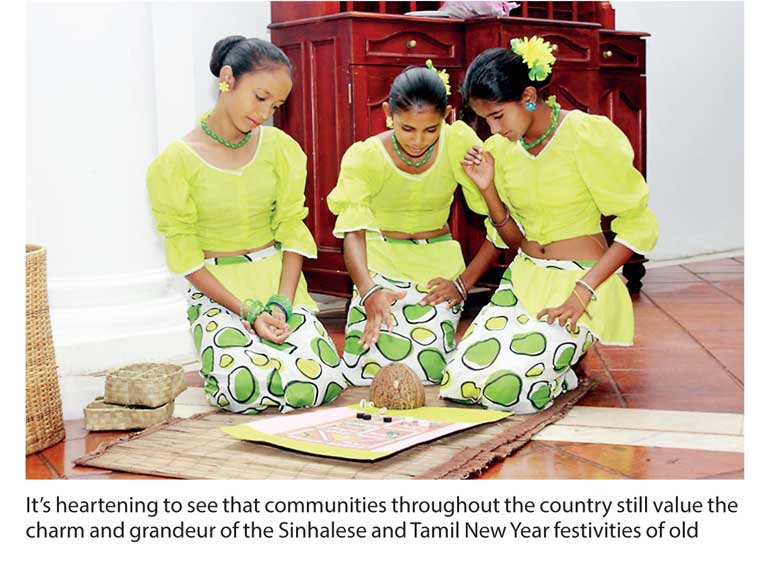Monday Dec 08, 2025
Monday Dec 08, 2025
Wednesday, 12 April 2017 00:00 - - {{hitsCtrl.values.hits}}
 Its Aluth Avurudu festivity time. There will surely be a rich spread of kavun, kokis and kiribath. The reverberating rhythm of the rabanas will fill the air.
Its Aluth Avurudu festivity time. There will surely be a rich spread of kavun, kokis and kiribath. The reverberating rhythm of the rabanas will fill the air.
In villages two teams would gather, seated on a mat and pitted against each other in the game of Panchi. It went something like this: seven sea shells (Panchis) with lead filled at the bottom to maintain weight and balance are rolled like dice from a cleaned coconut shell. The number of shells that fall with the lead up is what counts. Each side would have four markers (“Iththas”). These markers would advance on a ladder-like Chart (Panchi Petha) depending on the number of qualifying shells. The Iththas would travel in opposite directions to enable one team to capture the Iththas of the opposing team and get first to the winning post at the top of the chart. And the rules demanded that the team that loses is obliged to host the other team to a treat!
My friends in Jaffna recall with nostalgia how they would gather at the playgrounds in Jaffna to witness the ‘Poorthangai’ contests  as part of the festivities. While the crowds were munching murkku and ariatharan (sweets), cartloads of coconuts (thengai) would be hauled into the grounds in bullock carts (matuwandi). Young men would compete to hurl coconuts at those thrown by others and see who would best succeed in smashing open the coconuts thrown by the competitor.
as part of the festivities. While the crowds were munching murkku and ariatharan (sweets), cartloads of coconuts (thengai) would be hauled into the grounds in bullock carts (matuwandi). Young men would compete to hurl coconuts at those thrown by others and see who would best succeed in smashing open the coconuts thrown by the competitor.
Emotions would run high as the physical abilities, nerves and sinews were on display and put to test. My friends would marvel at the strength of the young lads in this “nut cracking” exploit to herald the Tamil New Year.
One feels nostalgic for the charm of the village life of old and the mind naturally wanders to the village playing fields where simple amusements and games give expression to this festive occasion.
What pleasures we derived in our childhood days in Kandy from those unsophisticated traditional games that were all part of the New Year celebrations. There was Gudu and Elle – two very popular games that provided as much excitement as any game of cricket or rounders would.
Pora-Pol Gahima – or bowling of coconuts – was another exciting pastime and often played between two sections of the village where spectators and supporters were known to bet heavily. An-Keliya or Hook Hugging was also a game where two sections of the village took part. The ‘An’ or ‘hook’ is made from strong timber and the game takes the form of tug-o-war causing much excitement and provoking cheers, jeers and laughter as often sarongs fall!
Coconut Scraping contests were conducted for village women, Olinda Keliya – an indoor game played on a hollow board with small red seeds of the olinda creeper – was an absorbing recreation and almost a monopoly of the women. Bola Keliya – a game played with marbles – was reserved for the little boys.
No festival celebration was without a Marathon or an Obstacle Race. Pillow Fights were also popular and of course, Climbing the Greasy Pole always provided the feverish climax.
Traditional games in ancient times were known to have taken a more dramatic turn and found popular flavour with all strata of society.
Cock fighting – one of the earliest games of the world was one the greatest pastime in Sri Lanka and a favourite during the New Year festivities. Here people used to bet gold, silver, lands and even their spouses! No wonder that at one time cock-fighting was banned.
Bull and Buffalo fights were also in vogue and the animals with sharpened horns were allowed to fight.
In medieval times even elephant fights were organised in specially constructed stockades. Here, two elephants were brought into the enclosure. If they do not fight, a gay female of the species is placed between them. Then overtaken by jealousy and sexual desire, they begin fighting. An extreme form of the ‘sport’ was the combat between two wild herds from different regions of the country.
A vivid description of an elephant fight that took place in 1883 goes as follows: “They advance into the centre of the square and join in battle seizing each other’s trunks, striking with trunks and feet and beating with the heads and tusks – some became weaker and ran away only to be chased and attacked brutally by the others…”
Thank heavens that traditional games in our time are a far cry from those of the bloodcurdling past. Although with each passing generation there is the danger of traditions and customs being eroded, it’s heartening to see that communities throughout the country still value the charm and grandeur of the Sinhalese and Tamil New Year festivities of old.